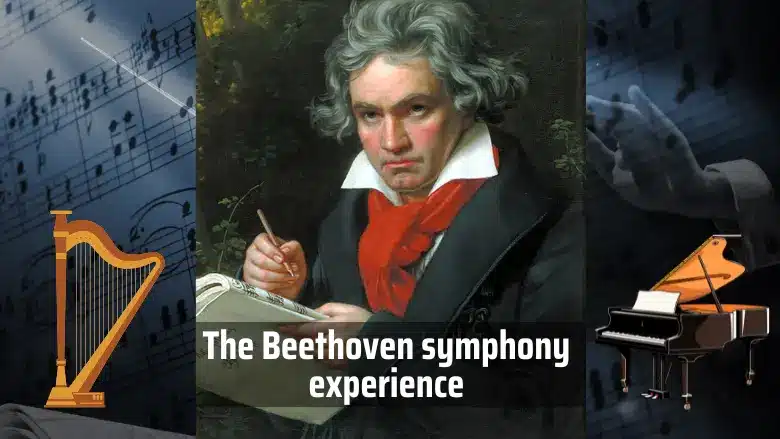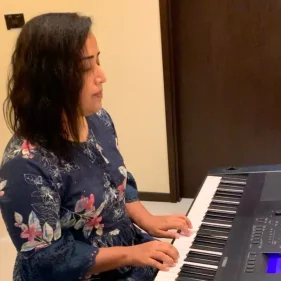- Symphony No. 1
- The Four Movements of Symphony No. 1
- Symphony No. 2
- The Four Movements of Symphony No. 2
- Symphony No. 3
- The Four Movements of Symphony No. 3
- Symphony No. 4
- The Four Movements of Symphony No. 4
- Symphony No. 5
- The Four Movements of Symphony No. 5
- Symphony No. 6
- The Five Movements of Symphony No. 6
- Symphony No. 7
- The Four Movements of Symphony No. 7
- Symphony No. 8
- The Four Movements of Symphony No. 8
- Symphony No. 9
- The Four Movements of Symphony No. 9
- Finale
- A deeper dive into the Finale of the Ninth Symphony
- Beethoven’s Symphony Recordings
- FAQs
“Mark that young man; he will make a name for himself in the world!” When such words come from one of the greatest musicians ever to grace the earth, the young man must possess extraordinary talent. But to whom did Mozart bestow this praise? And did the young prodigy fulfil the prophecy of the German maestro?
Allow us to reveal the name of the young lad so you can decide for yourself. The young man was the father of the Romantic era, Ludwig Van Beethoven. The Bonn-born musician has gifted the world numerous sonatas: 10 for piano, 2 for cello, and 3 for violin. Then he chose to create nine pieces of composition that will forever become a staple in the world of Western classical music, the “Nine Symphonies.”
The nine symphonies take the listeners on a musical journey and help us understand Beethoven’s journey as a musician, as all the compositions were composed in the span of a quarter of a century. Out of them, eight were composed within 13 years.
The fingers of a hand are not the same; however, they are unique and special in their own way. The same idea can be applied to all nine symphonies. In this Beethoven symphony analysis we will dive into different aspects, such as Beethoven symphony history and it’s list.
Symphony No. 1
It was the year 1800 when 29-year-old Ludwig van Beethoven chose to release his first-ever symphony at the Burg Theater in Vienna. The first symphony is Beethoven’s bird which spread its wings and took flight for the first time. The music piece is composed in C major. The orchestra for this composition includes 2 flutes, 2 oboes, 2 clarinets, 2 bassoons, 2 horns, 2 trumpets, timpani, and strings.

Did You Know?
Adagio molto is an Italian musical phrase. When translated to English, “adagio” means at a slow pace, and “molto” means extremely. When using both together, it is very slow or extremely slow. It is used to denote musical passages that should be played at an extremely slow pace.
The Four Movements of Symphony No. 1
Adagio molto—Allegro con brio
- Consisting of four movements, the composition begins with the Adagio molto—Allegro con brio. Like other symphonies of that time, the music piece had a slow introduction and started with a dissonant chord.
- The introduction keeps the audience intrigued till the music explores the quick tempo known as exposition. Beethoven chose two themes for the exposition: first, an introduction by strings, which added a perky melody.

Did You Know?
The tempo’s indication is marked as Allegro con brio, which means spirit, and the second theme is based on solo winds that find an accompaniment in strings.
- Then we reach the development section, which is where the composer is supposed to develop the material from the exposition. Beethoven kept this section quite adventurous and chose to further emphasize the themes that were introduced in the exposition.
- The movement ends with the recapitulation, which again explores the themes. After the little recap of sorts, Beethoven follows it up with a coda (which means tail), which includes a tutti section where the trumpet and timpani stand out.
Andante cantabile con moto
- In the second movement, Andante cantabile con moto Beethoven chose to sustain the vivacious energy; he not only chose to use the entire orchestra but also added more instruments, adding a timbral texture to the composition.
- The name of the movement “Andante cantabile con moto” means blowing and sunlight with forward motion. The movement is set in a three-eighths measurement. It starts with a simple fugue: first the second violins, then the violas, sequentially the cellos and basses, and finally ending with the first violins and winds.
Menuetto: Allegro molto e vivace
The third movement is named Menuetto: Allegro molto e vivace; however, its composition resembles more of a scherzo. The movement is faster and less predictable. The arrangement of this movement was one of the earlier examples of Beethoven’s future experimental nature.
Adagio-Allegro molto e vivace
The final movement of the first symphony, Adagio-Allegro molto e vivace, is like a box full of surprises. The movement starts with a rather slow introduction but soon livens up the atmosphere with an energetic sonata form.
Symphony No. 2
Sneak Peek Into the Creation of the Second Symphony
Next on the Beethoven symphonies list is the second symphony. For a deeper understanding of the symphonies, one must also learn about his life away from music. The challenges and circumstances he faced in his personal life greatly influenced his creations, including the symphonies. 1801-02 was a rather tumultuous and paradoxical time in Beethoven’s life. On one hand, he was garnering success and cementing his name as one of the prominent musicians of the era, but on the other, the German was struggling from the loss of hearing.
During the two years, his condition had deteriorated quite a bit, as he struggled through the harrowing pain of hearing loss; he chose to express his pain and anguish in words that we now know as the Heiligenstadt Testament of 1802. Despite the hardship, the Bonn-born composer chose the path of perseverance and put all his efforts into his musical creations. The symphony No. 2 is a window to the resilient spirit of Beethoven. Even though the second symphony gets overshadowed by the other symphonies like the third, fifth, or ninth. By looking a bit closer, one can see that it was the second symphony that laid the foundation for the musical revolution Beethoven would come to represent.

Did You Know?
During the classical period, symphonies usually consisted of a fast-slow-minuet-fast movement structure.
Beethoven first performed the 2nd symphony on 5 April 1803 during his concert at the Theater de Wien. The composition is known for its upbeat and sunny disposition. Mainly set in D major, the symphony follows the four-movement structure.
The Four Movements of Symphony No. 2
Adagio molto—Allegro con brio
- Beginning with the first movement, Adagio molto—Allegro con brio, composed in D major, the Adagio molto, as the name suggests, starts with slow music that carries a sense of gravitas.

Did You Know?
One of the most fascinating aspects of the introduction is its length. It is famously almost three times longer than the introduction of the first symphony.
- Following the sonata form in the first movement, the composition heads from the gradual sense of tension and anticipation of the introduction to a more lively Allegro con brio with more upbeat sixteenth and eighth notes with violas and cellos.
- The primary theme dabbles with the fun-spirited tune, and the secondary theme is much more lyrical and inspired by the French-inspired march theme.
- The development section focuses on delving deep into the themes introduced in the previous section with counterpoint and modulation.
- Then comes the recapitulation, where the themes are touched upon, ending the first movement with a rather lengthy coda, which is characterized as robust, upholding the primary theme of the allegro.
Larghetto
- The second movement of the second symphony is known as the Larghetto. Here the Bonn-born musician opts to showcase his expertise in dealing with melody. If the first movement is a fast-flowing river, then the second movement can be described as a gentle, meandering brook.
- The use of orchestration in this movement brings a bright, transparent feel to the movement, starting with the strings; the woodwinds play a crucial role in setting the serene atmosphere. Other accompaniments, such as clarinets and bassoons, further bring out the primary theme in the musical piece. The Larghetto helps solidify the contrasting nature of the entire musical composition.

Did You Know?
The second movement of symphony No. 2-Larghetto is considered one of the longest slow movements composed by Beethoven.
Beethoven’s experimental nature comes to light in the third movement of the second symphony. He chose to let go of the traditional ways and opted for a fun, bright, cheerful Scherzo instead of a minuet that is generally found in symphonic structures.
Scherzo
- The beginning of the Scherzo is like a burst of energy filled with quick changes between instruments and characterised by three-note gestures.
- Then it gives way to the trio section, which explores a more gentle pace with woodwinds and strings playing F-major arpeggios. It ends with a strong coda.
- The movement serves as an essential foundational layer of Beethoven’s evolution of his revolutionary mindset, which the world gets to witness in his future work.
Allegro Molto
- Beethoven ends the symphony with Allegro Molto. The movement ties all the loose ends with an energetic beginning, which is the main focus of the first theme. The second theme brings back the pattern of contrast, all thanks to the woodwinds and strings.
- Counterpoint, which Beethoven dabbled in within the previous movements, is once again brought back, and the symphony bids an enigmatic adieu to the audience with a grand coda ending on a high-spirited D major.

Did You Know?
Counterpoint in music refers to the layering of two or more melodies together, and modulation is when changing keys are used in a piece of music.
Symphony No. 3
Thoughts that led to the creation of Eroica
Ludwig van Beethoven was one of the pioneers who beautifully guided the transition between the Classical and Romantic eras. The end of the Classical and the beginning of the Romantic era came at a tumultuous time when Europe saw the emergence of new ideologies, visions, ideas, and thoughts.
There was a clash between the old and the new world—the French Revolution was one of the catalysts of this very change in human history. Beethoven belonged to the new world; he aligned himself with ideas such as liberty and equality, and the French Revolution was the vessel for the same ideas.
How does it relate to the third symphony?
Because it was Napoleon Bonaparte who initially inspired the creation of the famous Eroica. However, it was not a smooth ride, as Beethoven’s initial admiration for Napoleon Bonaparte was shattered when the French military officer declared himself Emperor of the French in the year 1804.
The declaration stood against the core ideas of the revolution: liberty, fraternity, and equality. Beethoven’s democratic beliefs led him to give new meaning to his creation. Eroica means heroism. Beethoven chose to dedicate the 3rd symphony to the idea of freedom rather than to a person whom he thought was an embodiment of those beliefs

Did You Know?
Initially, Ludwig Van Beethoven named the now-famous Eroica “Bonaparte” after the French military officer Napoleon Bonaparte.
The spark seen in the second symphony had totally transformed into the fire of revolutionary newness in the third Symphony. Beethoven chose to forge a new path for his symphony, mirroring the social and political climate of Europe during that time.
Just like its predecessor, the Third Symphony was first performed for the public at the Theater an der Wien on 7 April 1805. However, Eroica had already been introduced to an audience a year earlier, having its first performance at the Palais Lobkowitz in Vienna on June 9, 1804.
The Four Movements of Symphony No. 3
Allegro con Brio
- Eroica follows the four-movement structure; however, Beethoven deviated from the convention when choosing the character for the movements. In the first movement—Allegro con Brio. The Bonn native began the symphony with two strong E-flat major chords.

Did You Know?
E-flat major is usually used to denote the emotion of victory, triumph, grandeur, and heroism, just as the name of the symphony.
- From the very get-go, the composition is different from the traditional ideas; his predecessors, like Mozart and Haydn, would focus on presenting a rather neat and clear musical expression.
- Whereas Beethoven chose the path of introspection and made the audience dive deep into the meaning of his creation, ask questions, and find the meaning, especially through the opening theme.
- The development section focuses on the evolution of the music piece; even though the melody is introduced, the concept of heroism still leaves an incomplete impression.
- The rest of the pieces can be found in the recapitulation section, which revisits the first theme and lends more support to the heroic theme of the symphony.
- The E-flat major triad further facilitates the theme through various musical intricacies, and the unusually long coda brings back the initial melody in the movement.
Marcia Funebre Adagio Assai
- The second movement of Symphony No. 3 is a musical tribute to a fallen hero. The composer chose to name this movement Marcia Funebre Adagio Assai. “Marcia Funebre,” which translates to Funeral March, and he chose to express the theme through a very slow tempo—“Adagio assai.”
- Beethoven establishes the mournful atmosphere with basses acting as muffled military drums, and the use of C minor through strings is used to portray the sombre emotions of the procession.
- As the movement progresses, Beethoven introduces a triad theme in C major, which could indicate the past heroics of the now-fallen hero. Succeeded by a powerful fugue that works as a storyteller, telling the audience of the hero’s struggles, trials, and tribulations, which come to an end with the return of the funeral march.
- In the end, the coda of the movement enthrals the audience with a moment of silence followed by the last breaths of the hero before lying in the arms of death.
Allegro vivace
- In the third movement, Allegro vivace, the Minuet is once again replaced by a Scherzo. The woodwinds used could be interpreted as the depiction of the prancing of the horses. Adding to the vibrant and lively nature of this section.
- Beethoven chose to experiment and made the movement longer than the previous two symphonies. Even though this movement adheres to the traditional minuet trio structure, the Scherzo, because of its rounded binary form.
- It adds a more unique and experimental flavour to the movement, swaying it away from the usual classical structure. Lastly, the third movement comes to an end with a dramatic coda.
Allegro molto—Poco Andante—Presto
- The culminating movement of Eroica is titled Finale. Allegro molto—Poco Andante—Presto. From the tempo, one can see that Beethoven chose to take the audience through the entire journey one last time, as the movement is divided into three sections:
- very lively
- a little slow
- very fast.
- The movement explores themes of the hero’s journey, from the struggles to the Presto tempo in the coda, which signifies triumphant victory and celebration.
Symphony No. 4
Sneak Peek into the creation of the Fourth Symphony
Moving forward with Beethoven’s symphony analysis. It was 1806 when Europe was in the midst of the War of the Fourth Coalition. As we have previously established Beethoven’s stance on the matter, the political and social upheaval also had a major impact on his long-standing relationship with one of his patrons, Prince Karl Lichnowsky.
Turning the pages of Beethoven’s symphony history, one will come across the breaking of the alliance between the prince and Beethoven. According to the tale, the prince asked Beethoven to perform for a few of the guests who happened to be French soldiers. Given Beethoven’s beliefs, he refused the offer, and the difference in their decision led to a fallout between the two.
Many might think of symphony No. 4 as Beethoven’s attempt to return to a more traditional way of composing.
This symphony not as vivacious as its immediate predecessor or successor of Beethoven’s symphony no. 5 but it carries an air of simplicity. The simple nature of the symphony is reflective of the transitional phase between the Classical and Romantic eras of music.
Symphony No. 4 premiered at the Palais Lobkowitz in Vienna during the spring of 1807, followed by a public performance at the Burgtheater the following month.

Did You Know?
Robert Schumann famously described the symphony as “a slender Greek maiden between two Norse giants.” The two Norse giants are famous: Symphony No. 3 and Symphony No. 5.
The Four Movements of Symphony No. 4
Adagio-Allegro Vivace
- Tending more towards the classical style of composition, the first of the four movements starts with Adagio-Allegro Vivace.
- Taking the traditional route, the introduction is slow and introspective. Followed by the Allegro Vivace, which acts like a paintbrush, adding a bright, colourful tone to the movement.
- The primary theme in Allegro Vivace uses the arpeggiated chords on the first violin; the woodwinds then add melody to the section. The second theme begins with a bassoon followed by an oboe and a flute.
- The focal point of this theme lies in the solo woodwind. The recapitulation and the coda of this movement are relatively shorter when compared to Eroica.
Adagio
- If one looks back at Beethoven’s symphony History, his fourth symphony brought back the sonata form for the second movement of symphony No. 4—Adagio. This movement encapsulated the German’s genius when it came to understanding melodies.
- The first cantabile theme is crafted with the help of violins with pizzicato strings and woodwinds. The second dabbles with the sense of nostalgia with the help of subtle, tender orchestration.
- By this point, it had become a staple for the German composer to use Scherzo in the third movement. While the movement is labelled a Scherzo, it carries a lighter and more humorous tone, reminiscent of the Classical-era minuet.
- At the same time, the energetic rhythmic elements and sudden dynamic contrasts firmly establish it as a Beethovenian scherzo.
Allegro ma non troppo
- The final movement Allegro ma non troppo creates an effervescent and jubilant atmosphere. The first theme unveils the movement with beaming sixteenth notes in the strings, followed by the tutti chords.
- The second theme is quite the opposite, as it presents a more supple, bucolic melody with woodwinds, oboe, and flute complemented by triplets in the clarinets.
- The first theme is once again touched upon in the recapitulation with the help of orchestration, including solo bassoon. Lastly, with clarinet solos, the movement ends with a lavish coda.
Symphony No. 5
Sneak Peek into the creation of the Fifth Symphony
The second of the two Norse giants referred to by Robert Schumann was Beethoven’s symphony No. 5. Beethoven started composing the musical masterpiece around the same time as the Eroica in 1804; however, the completion of this symphony took longer than many of his other symphonic works.
It was first performed in December of 1808 alongside the Symphony No. 6 at the Theater-an-der-Wien. On the personal front, Beethoven was fighting one of the biggest battles of his life—the loss of his hearing.
Despite such harrowing conditions, Beethoven’s pure determination and love for music were unfettered. The symphony No. 5 could be interpreted as Beethoven’s refusal to bow down to his circumstances. Further, challenging the supposed fate that was written for him.
Beethoven’s symphony No. 5 was a musical marvel as it defied one of the conceptual foundations of classical music; it chose to focus on a more introspective style of music instead of the usual classical elegance and clarity.
Beethoven chose to give equal priority to each section of a movement: exposition, development, recapitulation, and coda. The structural balance was a new concept, especially when viewed through a classical lens in which a coda is usually used to bring a swift conclusion to a musical piece.
The Four Movements of Symphony No. 5
Allegro con Brio
- The first movement—Allegro con Brio—follows the sonata form and makes a lasting impression from the very beginning with the four-note motif.
- This simple yet attention-grabbing motif was not treated as a part of the symphony but was carried through the entire composition and was the crux of the entire theme that was explored throughout the four movements.
- The effect of romanticism can be felt through dramatic orchestrations that are used to depict the hero’s battles and struggles against the larger forces.
Andante con moto
The dramatic flair of the first movement finds tranquillity in the second movement—Andante con moto. Even though the movement carries hints of the fate motive, it primarily focuses on a more contemplative, calmer theme. Often seen as the calm before the storm.
Allegro-Trio
- Initially, the third movement—Allegro-Trio—was structured as a Scherzo and Trio with a repeated trio section, forming a five-part layout (Scherzo-Trio-Scherzo-Trio-Scherzo).
- Solo woodwinds and pizzicato strings among the varied instruments help create a buoyant and spirited atmosphere, while the timpani subtly integrates the four-note motif in the movement.
Allegro
- Triumphant Victory! The two words that best describe the final movement—Allegro. The key themes that were explored in the first three movements make a return and help in the culmination of the symphony in a grand, exuberant fashion.
- With C major, the anticipation and slow building of the crescendo from the Scherzo bridge reach the exalted point as the fourth movement begins.
- All the instruments are put into use to emote the feeling of victory, which includes the piccolo, contrabassoon, and a few others.
- In the development section, Beethoven finds his way back to the themes that were present during the Scherzo and the Bridge. Thus, the return was seen as a masterstroke by the German.
- This later facilitates the cyclical integration of all four movements in the future. The throwback to themes is further developed in the recapitulation section. Finally, the movement ends with one of the longest codas ever written by Beethoven.
Symphony No. 6
Sneak Peek into the creation of the Sixth Symphony
Up until the fifth symphony, Beethoven delved into concepts and themes that were heroic, dynamic, and grand in nature. His fervent spirit to carry on despite the cruel fate of the loss of hearing did not stop Beethoven’s journey as a musician.
Instead, those tumultuous times became fuel for his creative process, vividly reflected in his symphonies. The sixth symphony takes a step away from all the intensity and showcases a more carefree, lovable side of the music maestro.
The romantic ideal of self-expression was beautifully unveiled in symphony No. 6. With this symphony, Beethoven broke another traditional barrier; rather than composing a four-movement piece, he chose to incorporate five movements in symphony No. 6.

Did You Know?
The composition was one of the two symphonies that was personally named by the father of the romantic era—the pastoral.
The symphony made its debut along with Symphony No. 5 at Theater-an-der-Wien in December 1808.
The Five Movements of Symphony No. 6
Awakening of Cheerful Feelings Upon Arrival in the Countryside
- First Movement—“Awakening of Cheerful Feelings Upon Arrival in the Countryside” is curated in the sonata form. Unlike the previous hard-hitting introduction of the Fifth Symphony.
- For symphony No. 6 Beethoven chose a very pleasant and gentle introduction for the audience. This section was the composer’s way of appreciating the beauty and simplicity of nature through melodic rhythmic patterns played on a violin.
- The same pattern is quite evident throughout the movement. The development section momentarily breaks the smooth flow with sudden key shifts, which were used to indicate clouds covering the sun for a brief moment.
Scene by the Brook
- In the Second Movement—“Scene by the Brook,” Beethoven takes the listeners to a place of serenity and peace; the picturization of this movement includes the depiction of the gentle movements of a brook through the continuous tripled figures played through the strings.
- The flutes and violins were used together to generate trills that mimic the chirping of the birds. The musical maestro used different instruments to represent different birds: a solo flute was used to emulate the song of the nightingale, a solo oboe to mimic the whistling of a quail, and two clarinets for the call of the cuckoo.
Merry Gathering of Country Folk
- The sweet, sober second movement gives way to the merry and cheerful third movement—Lustiges Zusammensein der Landleute translates into “Merry Gathering of Country Folk.”
- The jovial and festive theme is the central point of this movement. Through this, Beethoven depicts the happy times when the village folks come together and celebrate life through drinking and dancing.
Thunderstorm; Storm
- The Fourth Movement—“Gewitter, Strum” or “Thunderstorm; Storm”—takes” a rather sombre, dark turn where the Bonn-born musician paints a picture of a thunderstorm brewing.
- Diminished seventh chords illustrate the tension and the anticipation of the incoming rain; the rumblings of the distant wind are depicted through tremolo played on low strings.
- The heavy rain and storm are marked with the help of tutti. The timpani and brass start fading away, signalling how the storm slowly subsides and the sun shines again on the countryside with the return of woodwinds.
Shepherd’s Song: Happy and Thankful Feelings after the Storm
- The fifth Movement and final movement, “Hirtengesang. Frohe und dankbare Gefühle nach dem Sturm, or the “Shepherd’s Song: Happy and Thankful Feelings after the Storm.”
- Showcases the post-storm countryside and touches upon the shepherd’s feeling of relief and joy for surviving the passing of the storm.
- The first theme retains the folk-like characteristics with the help of flutes and clarinets along with other instruments. The second and closing themes reinforce the pastoral theme with the return of birdlike trills.
Symphony No. 7
Sneak Peek into the creation of the Seventh Symphony
Symphony No. 7 came four years after the release of the Pastoral Symphony. In 1811, Beethoven had lost most of his hearing ability. The German took some time away from the bustling streets of Vienna and went to the countryside in Teplice in an attempt to regain some strength and aid his worsening health condition. The peace of the countryside inspired the creation of Symphony No. 7.
After its completion in 1812, it was played for the first time in the Akademie at the University Concert Hall, Vienna, on 8 December 1813. The concert in which the symphony was first performed was one of Beethoven’s most successful concerts, organized for the soldiers of the Battle of Hanau.
The Four Movements of Symphony No. 7
Poco sostenuto-Vivace
- The first movement Poco sostenuto-Vivace uses the sonata form and has the longest introduction among all Beethoven symphonies.
- The poco sostenuto tempo is used for the slow introduction, then picks up the pace as the movement moves towards the livelier and upbeat Vivace tempo.
Allegretto
The second movement—Allegretto has a separate fanbase in the world of music. The rhythmic motive of this movement stands out. It explores the theme of melancholy with a touch of hope. The movement starts and ends on the same A minor chord.
Presto—Assai meno presto
- The third movement, Presto—Assai meno presto, encompasses a scherzo-trio structure. Unlike the previous movement’s theme, this movement is filled with vigour and zest.
- This also happens to be the longest of Beethoven’s Scherzo among his symphonies. The two main components that build this section are the prancing Presto and a relatively laid-back trio section.
Allegro con brio
- The fourth movement—Allegro con brio—opens with the A major and does justice to the lively, triumphant spirit of the movement through rhythmic intensity; it carries on the energy from the previous movement.
- It also continues the implementation of the sonata rondo form. The coda is once again used as an experimental canvas where Beethoven explores different rhythmic dynamisms.
Symphony No. 8
Sneak Peek into the creation of the Eighth Symphony
One might associate words like majestic, grand, and gravitas with Beethoven’s compositions. However, the emotions that are often overlooked in his work are humour and wit.
The symphonies that came before Symphony No. 8 explored various themes: heroism, pastoral themes, and the dichotomy of life. By 1812, Beethoven’s deafness had advanced significantly, but it could not deter him from his piano or music sheets.
According to Beethoven’s symphony history, this one was completed in the final months of 1812 but wasn’t released until years later. The German maestro showcased another facet of his genius during the debut performance at the Akademie in the Palace Redoutensaal, Vienna, on February 27, 1814, with Beethoven himself leading the orchestra.
The Four Movements of Symphony No. 8
Allegro Vivace e con brio
- The four-movement structure starts with an Allegro Vivace e con brio. Right from the start, Beethoven breaks from the traditional slow, gravitating introductions of the classical style, opening with a vibrant, energetic, and spirited theme.
- In the first theme, however, he incorporates the elegance of the classical era, dividing it into three equal parts.
- The structure of this section follows Joseph Haydn’s blueprint: the question posed by the full orchestra is answered in two parts.
- First, with the clarinets playing in four measures, followed by a full orchestral response, also in four measures.
Allegretto Scherzando
- Beethoven explores the scherzo in the second movement, Allegretto Scherzando. The whimsical, light, and fast-paced nature of the movement allows the Maestro to delve into its comical aspects—such as the ticking motive and the emulation of footfalls and laughter.
Tempo Di Menuetto
The third movement maintains the comical theme while returning to a more traditional structure with the Tempo Di Menuetto. A standout feature of this movement is the beautifully orchestrated trio section. which showcases instruments like two horns and a clarinet, accompanied by light bass and the occasional inclusion of strings. Together, they create a pastoral environment for the listeners.
Allegro Vivace
At the very helm of the symphony, Beethoven chose Allegro Vivace to end his eighth symphonic creation. The tempo gives the movement a vibrant and lively texture. The German composer brings back the wit that he showcased earlier in the scherzo. Creating a grand ending with the octave motive that is accompanied by the timpani and F major chords.
Symphony No. 9
Sneak Peek into the creation of the Ninth Symphony
Beethoven bids adieu to his symphonic creations with symphony No. 9. The symphony serves as the perfect climactic ending to the German maestro’s 25 years of producing nine symphonies. The final symphony was a testament to Beethoven’s sheer patience, as the creation of the symphony started way back in 1814-1815, somewhere along the symphony No. 8.
However, the Bonn-born native took special care when curating the musical masterpiece. The foundation upon which the Symphony stands is the poem by Friedrich Schiller, “Ode to Joy.” Thus the Symphony is also known by the same name.
By this time we all know how keenly Beethoven felt towards the ideas of freedom, brotherhood, and equality, and all those ideas were penned down by the German poet and playwright in his 1786 poem Ode to Joy. Beethoven was like a sculptor, and the symphony was like the diamond, which he carefully sculpted over many years, that finally shone in all its glory in the summer of 1824 on May 7th at the Kärtnerthor Theater, Vienna.
Ludwig Van Beethoven gives the musical composition a theatrical flair. In terms of Beethoven symphony analysis one can divide the four-movement piece can be seen as a two-act drama. The 1st act is the first three movements serving the purpose of setting the theme and emotions.
The last movement becomes the magnificent second act, which becomes a musical interpretation of the poem Ode to Joy, where the concepts of joy and unity are celebrated.
The Four Movements of Symphony No. 9
Allegro man un tropo
- The beginning of the first act or the first movement Allegro man un tropo, un poco maestoso is shrouded in the air of mystery; the main note, D minor, is not heard until the 13th bar.
- However, the introduction of the fort theme feels extremely organic without a dramatic tempo change, unlike the Germans’ earlier symphonies, like the fourth and the seventh.
- Breaking with convention, Beethoven shifts to the key of B-flat major for the second theme, adding intrigue to the musical narrative and keeping listeners engaged.
- Following the experimental path, Beethoven chose to omit the repetition of the exposition altogether and headed towards the development section.
- But he stages the section in such a way that it gives an impression of the exposition starting. Through the skipping of the repetition, the musical genius blurred the lines between symphonic music and stage music.
- Rather than dabbling with the already present themes, Beethoven goes on to introduce new themes in the development section, a practice that he began with his Third symphony.
- Here, in the Ninth symphony, Beethoven highlights the key of A minor, which then shifts to A major, giving the new theme its own distinct platform within the movement
- Recapitulation with a twist, this section of a movement feels like returning to your roots (in symphonic language, it’s the first theme).
- However, Beethoven had other plans; rather than starting the section with D minor, he chose D major. Deviating further, the basses, comprising cellos and basses, go on to play the not F-sharp instead of the root note D. A similar treatment of the first movement was seen in the Eighth Symphony.
Molto Vivace–Presto
- The second movement, Molto Vivace–Presto, showcases Beethoven’s mastery of the Scherzo, which he had been refining since its transformative use in the Eroica symphony.
- Over the years, Beethoven elevated the Scherzo from a simple dance form into a more complex and dynamic structure. By the time he reached the Ninth Symphony.
- Just like the evolution of a caterpillar to a butterfly, Beethoven’s use of this pattern fully evolved into a full sonata-allegro form.
- Another callback to his earlier symphony was the use of the fugue, which was prominently featured in the Trio of the fifth symphony.
- In the Ninth Symphony, however, he expands the fugue’s role, weaving its intricate counterpoint throughout the entire Scherzo.
- Beethoven brings a balanced ending to the section with the incorporation of the joyful trio, which becomes the contrasting element to the intense Scherzo.
Adagio molto e cantabile—Andante Moderato
- In the last part of the first act, the third movement—Adagio molto e cantabile—Andante Moderato, Beethoven introduces variations in this movement. The variation alterations are not as strict as were seen in the fifth symphony.
- The first theme is set in B flat major, and the second theme is composed in D major. Unlike the previous two movements, the themes explored in this movement are much more serene and calmer. It serves as a breather and prepares the listeners for the grandiosity of the finale.
Finale
- Beethoven lays it all bare as he reaches the finale of the ninth symphony. The significance of the creation of the fourth movement does not only restrict itself to the musical realm but transcends beyond that into social and political themes as well. Beethoven wears the crown of a storyteller.
A deeper dive into the Finale of the Ninth Symphony
Sinfonia
- The fourth movement begins with the “sinfonia” and the “prologue” in an opera-like manner with instruments and successfully catches the attention of the listeners with the loud clashing of the two chords, D minor and B flat major.
- The back and forth between the two keys feels like a battle between two fencers. After the theatrical introduction, the cello and basses heighten the operatic feel by incorporating instrumental music, which is usually accompanied by music that is being sung.
- Simultaneously, Beethoven tips his hat to his earlier creations, commemorating his symphonic journey. The recitative section gives way to a more joyful melodic section.
- After which the two fencers (D minor and B flat major) make a return. But this time around, a solo bass singer lends his voice to the instruments. Singing the words, “Oh friends, not these notes.”
Ode to Joy
- Beethoven then heads to Schiller’s Wisdom, the ode. Here the bass singer finishes his part and proceeds to sing “Ode to Joy.”
- The text is arranged in a theme variation structure, where one section is built upon the last, adding to its complexity with each progressive section.
Epilogue
The epilogue begins softly but bursts into a celebratory mood with the D major. All the voices and the instruments come together perfectly, encapsulating the feeling of unity, and the divinity of the Spark is further highlighted as the chorus sings about the creator’s love. Beethoven gives the symphony an opulent orchestral finish.
Beethoven’s Symphony Recordings
Over the centuries, many musicians have chosen to honour the German legend by recreating his magic on stage. We have listed out some of the recordings that have garnered immense praise all around the world and curated a Beethoven symphony listening guide of the renditions that are considered to be among the best Beethoven symphony recordings.
Leipzig Gewandhaus Orchestra/Riccardo Chailly Decca 478 3493 – Starting with Riccardo Chailly and the Leipzig Gewandhaus Orchestra’s rendition of Symphony no. 1 & 2, it received immense love upon its release on 6th February 2012. For the second symphony, one must tune into Saarbrücken Radio Symphony Orchestra/Stanisław Skrowaczewski OEHMS OC522, released in 1998. The perfect recording to experience the beauty of Eroica is the EMI release with catalogue number 636 5552, which featured Beethoven’s symphony No. 3 conducted by Rudolf Kempe with the Münchner Philharmoniker.
Beethoven symphonies Nos. 4 & 7″ by the Academy of St Martin in the Fields, conducted by Joshua Bell, is the go-to, especially when it comes to the fourth symphony. Beethoven’s symphony No. 5 by the Vienna Philharmonic Orchestra, conducted by Carlos Kleiber in the 1970s, remains one of the most iconic performances of Beethoven’s symphony to date. For the Sixth Symphony, we will explore the 1980s London Classical Players conducted by Roger Norrington.
Riccardo Chailly makes a return to the list for the Seventh Symphony with Gewandhausorchester Leipzig/Riccardo Chailly Decca 478 3496. For the eighth symphony, one must turn the time back to the 1970s and listen to the recording by the Vienna Philharmonic under Claudio Abbado. Lastly, for the Ninth Symphony, one must turn to Osmo Vänskä and his Minnesota Orchestra’s 2006 performance to experience the “Divine Spark” of Ode to Joy.
FAQs
What is Beethoven’s most famous symphony?
Beethoven’s most famous symphony is Symphony No. 9, also known as “Ode to Joy”
Why is Beethoven’s Symphony No. 9 so popular?
Beethoven created Symphony No. 9 by using Friedrich Schiller's “Ode to Joy.” and incorporating the poem in the music piece. Despite his deafness, the German was able to create a masterpiece celebrated worldwide as an anthem for unity and hope.
How many symphonies did Beethoven compose?
Beethoven composed 9 symphonies during his lifetime.
What is unique about Beethoven’s Symphony No. 5?
The most unique thing about the Fifth Symphony is the four-note motif, also known as “fate knocking at the door.”
What is the meaning of Beethoven’s Symphony No. 9?
Beethoven’s Symphony No. 9 is a celebration of human unity, peace, and brotherhood.
Why is Beethoven’s Symphony No. 5 important?
Beethoven’s Symphony No. 5 is important for its groundbreaking structure, innovative use of motifs, and its influence on the evolution of classical music
What language is Beethoven’s Symphony No. 9, “Ode to Joy in”?
The fourth movement of the Symphony No. 9 is sung in German.
Which Beethoven symphony is known as Eroica?
Beethoven’s Symphony No.3 is known as Eroica.
How long does Beethoven’s Symphony No. 7 last?
Beethoven's Symphony No. 7 typically lasts about 40 to 45 minutes, depending on the tempo chosen by the conductor and the overall pacing of the performance.
Related Blog : Vivaldi Four seasons































